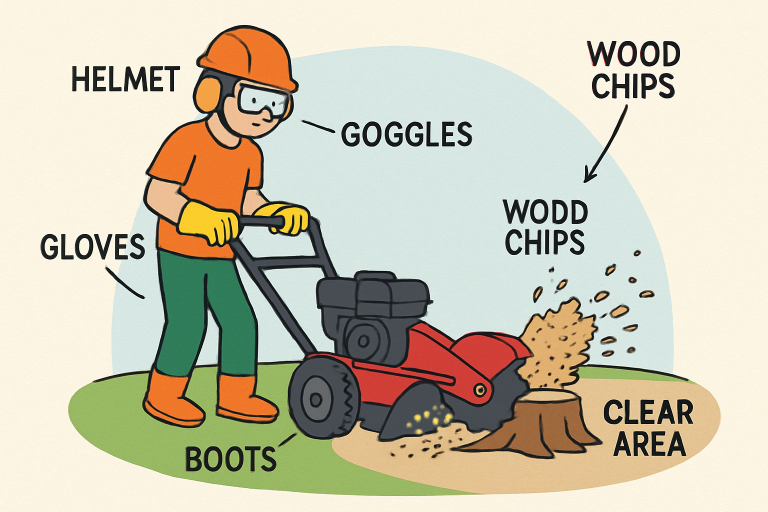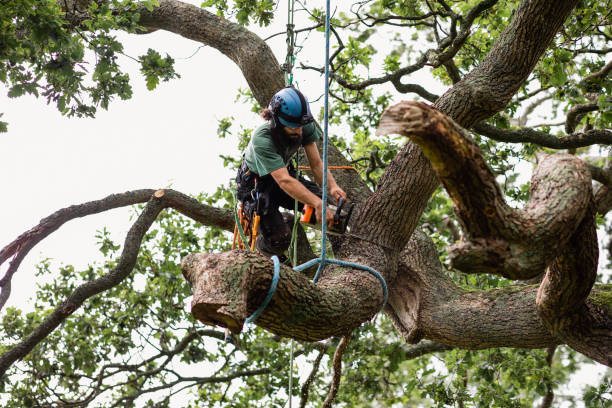Stump Grinding Techniques: Ensuring Safe and Efficient Tree Removal
Key Takeaways
- Stump grinding efficiently removes tree stumps while enhancing landscape safety and appearance.
- Prioritizing safety precautions for both operators and bystanders is crucial throughout the grinding process.
- Modern equipment and environmentally friendly practices contribute to effective, sustainable outcomes.
- Proper cleanup and ongoing maintenance help preserve equipment longevity and site usability.
Table of Contents
- Understanding Stump Grinding
- Essential Safety Precautions
- Effective Stump Grinding Techniques
- Environmental Considerations
- Innovations in Stump Grinding Equipment
- Time Considerations for Stump Grinding
- Post-Grinding Cleanup and Maintenance
- Conclusion
Understanding Stump Grinding
Stump grinding is a specialized method that eliminates tree stumps from your property by reducing them to small wood chips with powerful, mechanized equipment. Homeowners and landscapers often choose stump grinding as an alternative to complete stump removal because it is minimally invasive and leaves the surrounding landscape mostly undisturbed. Whether you are clearing land after new house construction or simply enhancing your yard after tree removal, professional tree removal followed by stump grinding ensures a safer, more appealing environment.
Beyond aesthetics, stump grinding is vital for eliminating hazards such as tripping and providing a clean slate for future landscaping. Decaying stumps can attract pests such as termites and beetles, increasing the risk to both property and nearby healthy trees. This technique ensures a swift transition from an unsightly stump to usable garden space, all while reducing environmental impact compared to chemical stump removal.
Essential Safety Precautions
Safety should always be the highest priority when it comes to stump grinding. Operators must wear personal protective equipment (PPE), including helmets, face shields or goggles, ear protection, heavy-duty gloves, and steel-toed boots. Loose wood chips and flying debris can pose serious risks to the eyes and skin, while the machine itself produces significant noise levels that can damage hearing if precautions are not observed.
Thoroughly inspecting the grinder prior to use is critical. Ensure that all guards, blades, and moving parts are secure and that the engine or motor is functioning correctly. Marking a safety perimeter around the stump-grinding site ensures that pets, children, and bystanders remain at a safe distance during the operation.
For landowners seeking dependable results and minimized risk, relying on stump grinding experts is a smart move, as they bring the professional skills and modern protective gear necessary for complicated or large-scale stump removals.

Effective Stump Grinding Techniques
Site Preparation
Begin by thoroughly clearing the area around the stump. Remove rocks, decorative stones, branches, or any other debris that could interfere with equipment operation or pose a hazard as projectiles. Carefully exposing the stump base and primary roots ensures a smoother grinding process and prevents blade damage.
Equipment Positioning and Grinding
Properly positioning the grinder is essential for an efficient job. The cutting wheel should be aligned slightly above the stump surface, with the machine stable and secure. As you operate the grinder, engage the cutting wheel and methodically move it side-to-side, lowering it after each pass to incrementally chip away the wood. This measured approach keeps the machine from overloading and produces finer mulch for easy cleanup.
Depth Control
It’s generally recommended to grind the stump to a depth of 4 to 6 inches below ground level, effectively minimizing the risk of regrowth and simplifying the process of replanting or adding sod. Monitoring depth is crucial—too shallow and the stump may sprout again, too deep and you may cause unnecessary damage to the soil structure.
Environmental Considerations
Compared to chemical or manual methods, stump grinding is notably kinder to the environment. The process leaves behind wood chips that can be recycled as mulch, nourishing the soil and improving moisture retention around garden beds. By avoiding chemical treatments, you protect soil health, wildlife, and local water resources from potential contamination. According to the EPA, incorporating eco-friendly practices like these is a key way to achieve greener landscaping and reduce environmental impact.
Using sustainable landscaping techniques not only benefits the environment but also enhances the beauty and health of your garden over time. Small steps like these can make a meaningful difference in creating a more eco-friendly outdoor space.
Innovations in Stump Grinding Equipment
Technological advances in stump grinding equipment mean today’s machines are more powerful, easier to maneuver, and better for delicate landscapes than ever before. Hydraulic controls enable operators to finely adjust the angle, depth, and speed, resulting in a smoother finish and drastically reducing the need for follow-up landscaping. Battery-powered and low-emission grinders are emerging on the market, further reducing noise and environmental impact during residential projects. These innovations not only improve operator efficiency but also provide significant value for property owners by minimizing disruption and maintaining site integrity throughout the process.
Time Considerations for Stump Grinding
The duration of the grinding process is determined by the stump’s species, size, and the type of equipment used. Small stumps under 12 inches in diameter can be eliminated in less than an hour with a homeowner-grade grinder. In comparison, medium stumps (12-24 inches) can take up to three hours if roots are gnarly and conditions are challenging. Large or multiple stumps or outdated machinery can extend the job to several hours or more. Tree service professionals using commercial grinders dramatically reduce these timeframes and improve efficiency, especially for large-scale jobs.
Post-Grinding Cleanup and Maintenance
Cleaning up after stump grinding ensures the site remains safe, tidy, and ready for future use. Rake up the sawdust and chips, relevel the area, and backfill the hole with fresh soil if needed. Replanting grass or ground cover is recommended to restore the landscape. Ongoing maintenance of your grinding equipment, such as blade sharpening and periodic inspections, will extend the tool’s service life, ensuring reliable, smooth operation in the future.
Conclusion
Stump grinding provides a safe, eco-conscious solution for removing unsightly or hazardous tree remnants. Understanding each step—from safety protocols to site cleanup—enables homeowners and property managers to achieve attractive, functional landscapes. Integrating the latest machinery and adhering to environmental best practices elevate the process even further, resulting in safer spaces and sustainable, healthy landscapes for years to come.




